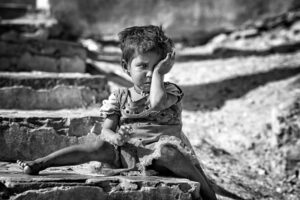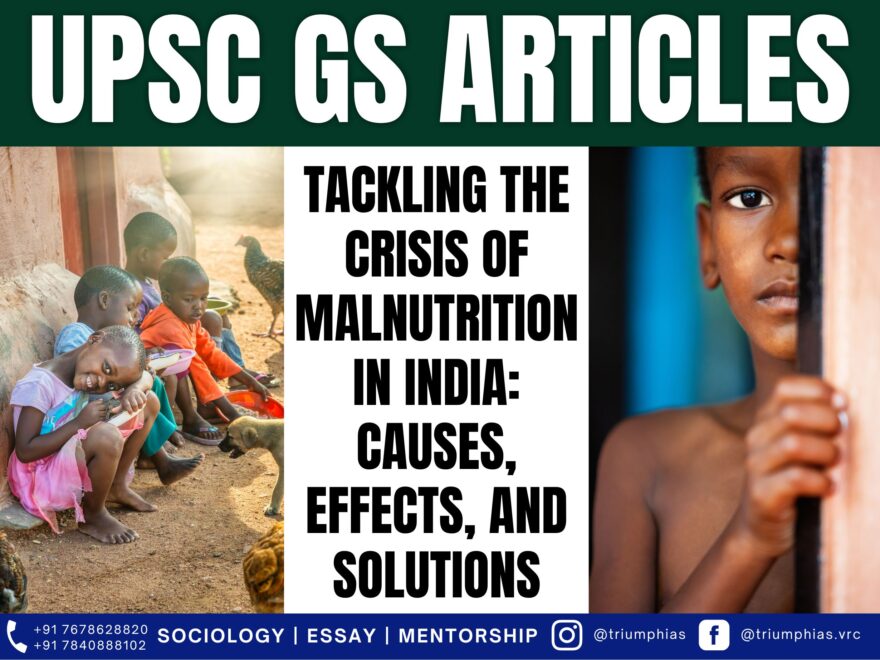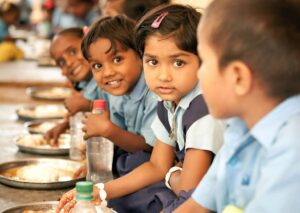Tackling the Crisis of Malnutrition in India
(Relevant for General Studies Paper Prelims/Mains)

Malnutrition: Hidden Challenge for India
As India embarks on the Amrit Kaal, a 25-year journey leading to India@100, there is ample cause for pride. Notable progress has been achieved in the realms of science, technology, and medicine, enriching the nation’s venerable heritage of traditional wisdom and civilization.
Nonetheless, it remains disconcerting that even after seven decades of independence; India continues to grapple with pressing public health concerns like child malnutrition. Inadequate nutrition not only detrimentally affects health and survival but also hampers cognitive development and academic performance among children. Moreover, it translates into reduced income-earning potential in adulthood and heightened susceptibility to chronic ailments like diabetes, hypertension, and obesity.
Effect of malnutrition on India
- According to data from Worldometer, India currently holds the regrettable distinction of being the world’s primary contributor to a population experiencing undernourishment, with an estimated 14.37% of its residents lacking access to sufficient nutrition.
- The findings from the Government’s National Family Health Survey 5 (NFHS 5) paint a disquieting picture of India’s nutritional health situation:
- Stunted growth is observed in 36% of children under the age of five.
- Approximately 19% of these young children suffer from wasting.
- A significant 32% are classified as underweight.
- Meanwhile, a smaller 3% fall into the overweight category.
- The prevalence of anemia, which is marked by low hemoglobin levels, is alarmingly high, affecting a staggering 67% of children below the age of five.
- Digging deeper into these statistics reveals stark gender disparities. Women, in particular, bear a disproportionate burden, with a substantial 57% of Indian women grappling with anaemia, compared to the relatively lower rate of 25% among men under the age of 50.
- Furthermore, about 19% of women and 16% of men under the age of 50 contend with undernourishment, while a notable 24% of women and 23% of men struggle with obesity.
- These figures collectively underscore the sombre reality that nearly 40% of India’s expansive population, which boasts a total of 1.4 billion individuals, faces the challenging issue of malnutrition in its various forms.
Primary Causes behind prevailing Malnutrition in India
Economic Disparities: Owing to the economic disparities prevalent in various segments of the population, a significant portion often grapples with inadequacies in both the quality and quantity of their diet. Those with limited financial means often find it challenging to afford nutritious food or encounter barriers in accessing it. Additionally, they are susceptible to food insecurity, which may arise from natural calamities, conflicts, or fluctuations in prices.
Inadequate Primary Healthcare Infrastructure: A considerable portion of India’s populace lacks access to fundamental healthcare services, including immunization, antenatal care, and treatment for common infections. This deficiency amplifies the risk of diseases and complications that can exacerbate the issue of malnutrition.
For context, the World Health Organization (WHO) recommends a doctor-to-population ratio of 1 per 1000 and an ideal nurse density of 3 per 1000 individuals. In contrast, India currently has only 0.73 doctors and 1.74 nurses per 1000 people.
Lack of Awareness and Low Literacy Rates: Many individuals within India are unaware of the critical importance of proper nutrition and may lack knowledge regarding best practices to ensure it. This includes the preparation of balanced meals, awareness of foods to avoid during pregnancy and breastfeeding, and methods to prevent micronutrient deficiencies. Illiteracy compounds this challenge by restricting access to information and educational resources related to nutrition.
Challenges in the Public Distribution System (PDS): The Public Distribution System, a government initiative designed to provide subsidized food grains and essential commodities to impoverished households, grapples with numerous issues. These encompass corruption, leakage, diversion, substandard quality, and insufficient coverage. Consequently, numerous individuals in need of food assistance either do not receive it or obtain inadequate quantities.
To provide context, a report by the Comptroller and Auditor General (CAG) revealed that merely 49% of the allocated food grains under the PDS reached their intended beneficiaries in the fiscal year 2012-13.
Ineffectual Implementation of the Integrated Child Development Scheme (ICDS): The Integrated Child Development Scheme, another government endeavour, aspires to enhance the nutrition and health of children under six years of age and pregnant or lactating women. It offers supplementary food, health check-ups, immunization, growth monitoring, and pre-school education via anganwadi centers, which are community-based mother and child-care facilities.
Nonetheless, the ICDS faces several impediments, including inadequate funding, staff shortages, subpar service quality, and low participation rates. According to the National Family Health Survey-5 (NFHS-5), merely 50.3% of children under six years received any service from an anganwadi center in the past six months.
Inadequate Sanitation: Subpar sanitation and hygiene practices heighten the risk of exposure to pathogens and parasites that can induce infections and diseases. Such health issues can impair the absorption and utilization of nutrients in the body, consequently contributing to malnutrition. As per the NFHS-5 findings, a mere 69% of households employ an improved sanitation
Ways to Tackle Malnutrition
- Develop a Focused Action Plan for Social and Behavior Change Communication (SBCC): States should collaborate in formulating a well-structured SBCC Action Plan tailored specifically to address malnutrition. This comprehensive plan should outline objectives, target audiences, key messaging, and effective communication strategies.
- Incorporate Nutrition Counselling into Healthcare: Nutrition counseling should be seamlessly integrated into the healthcare system as a foundational element. This entails embedding it within existing healthcare infrastructure, including primary health centers and community health initiatives, to make it an integral part of routine healthcare services.
- Promote Exclusive Breastfeeding (EBF) Awareness: Highlight the critical significance of exclusive breastfeeding during the initial six months of an infant’s life. Launch awareness campaigns aimed at educating mothers and families about the advantages of EBF, encompassing optimal techniques for breastfeeding, including holding, latching, and proper breast emptying methods to enhance milk transfer.
- Antenatal and Postnatal Breastfeeding Guidance: Enforce a systematic approach to deliver breastfeeding counseling to expectant mothers during antenatal checkups, extending this support through regular home visits post-delivery. Research demonstrates that such counseling substantially enhances breastfeeding practices and mitigates under nutrition.
- Enhance Complementary Feeding Practices: Address deficiencies in complementary feeding practices by instructing parents and caregivers on the appropriate time to commence complementary feeding (around six to eight months), what and how to feed, feeding frequency, and suitable portions. Ensure that this information is accessible across all socio-economic strata.
- Engage the Prime Minister’s Support: Mobilize the Prime Minister’s involvement to offer robust backing and visibility to nutrition programs, in a manner akin to initiatives like the Swachh Bharat Abhiyaan. Utilize platforms such as ‘Mann Ki Baat’ to facilitate resource mobilization and heighten public awareness.
- Reevaluate and Refine POSHAN 2.0: Undertake a comprehensive assessment of the implementation of the POSHAN 2.0 program to identify and rectify any shortcomings. Ensure that the system effectively reaches mothers and children during the critical first 1,000 days of life.
- Explore Alternative Distribution Channels: Evaluate the feasibility of dispensing supplementary nutrition items, such as Take-Home Ration packets, through the Public Distribution System (PDS) to free up anganwadi workers for counselling. This can streamline the delivery of essential nutrition to beneficiaries.
- Integrate Human Resources: Design and pilot a new framework that harmonizes the human resources of the Integrated Child Development Scheme (ICDS) with the healthcare system, spanning from the village to the district and state levels. Such integration would establish a more efficient and accountable mechanism for providing services during a child’s first 1,000 days.
- Leverage Mass Media: Harness the potential of mass media and television programs to facilitate informative dialogues and discussions on infant and young child care throughout the first 1,000 days. This approach can extend outreach to mothers and caregivers beyond the confines of the public health system.
- Continuous Monitoring and Evaluation: Institute a robust monitoring and evaluation system to assess the efficacy of these interventions. Adjustments should be made based on results to ensure a sustained reduction in child malnutrition
Basics
- Malnutrition encompasses a range of conditions characterized by deficiencies or excesses in nutrient intake, imbalances in vital nutrients, or impaired nutrient utilization.
- The double burden of malnutrition encompasses both under nutrition and the issues of overweight and obesity, coupled with diet-related non communicable diseases.
- Under nutrition presents itself in several primary forms, including wasting, stunting, underweight, and deficiencies in essential micronutrients.
- Wasting refers to a condition where an individual has a low weight-for-height ratio. This often signals recent and severe weight loss, although it can persist over extended periods. Typically, it arises due to inadequate food quality and quantity or frequent and prolonged illnesses. In children, wasting poses a substantial risk of mortality if not adequately addressed.
- Stunting is characterized by a low height-for-age ratio and results from chronic or recurrent under nutrition. It is frequently linked to factors such as poverty, maternal health and nutritional shortcomings, frequent illnesses, and improper feeding and care during early life. Stunting hinders children from reaching their full physical and cognitive potential.
- Underweight is defined by a low weight-for-age ratio. A child who is underweight may also exhibit stunted growth, wasting, or a combination of these conditions.
Sample Question for UPSC Sociology Optional Paper:
Question 1: What role does economic disparity play in contributing to malnutrition in India?
Answer: Economic disparity significantly contributes to malnutrition in India by limiting access to quality food and healthcare, leading to inadequacies in both the quality and quantity of people’s diets.
Question 2: How does inadequate primary healthcare infrastructure exacerbate the problem of malnutrition in India?
Answer: Inadequate primary healthcare leads to a lack of essential services like immunization and antenatal care, thereby amplifying the risk of diseases that can exacerbate malnutrition.
Question 3: Evaluate the effectiveness of government initiatives like ICDS and PDS in addressing malnutrition.
Answer: Despite their objectives, both ICDS and PDS have faced challenges like inadequate funding, staff shortages, and corruption, making their effectiveness limited in addressing malnutrition comprehensively.
Question 4: Discuss the importance of education and awareness in combating malnutrition in India.
Answer: Lack of awareness and low literacy rates hinder effective nutritional practices. Education can empower people to make informed choices about their diet and lifestyle, significantly reducing malnutrition.
Question 5: What is the ‘double burden’ of malnutrition and how is it manifesting in India?
Answer: The ‘double burden’ of malnutrition refers to the co-existence of undernutrition along with overweight and obesity. In India, while a significant percentage of the population suffers from undernutrition, obesity is also on the rise, thereby creating a double burden.
To master these intricacies and fare well in the Sociology Optional Syllabus, aspiring sociologists might benefit from guidance by the Best Sociology Optional Teacher and participation in the Best Sociology Optional Coaching. These avenues provide comprehensive assistance, ensuring a solid understanding of sociology’s diverse methodologies and techniques.
Malnutrition in India, Child Malnutrition, NFHS 5, Public Health, India’s Health Crisis, Economic Disparities, Primary Healthcare, POSHAN 2.0, ICDS, Public Distribution System, Stunting, Wasting, Anaemia, Nutrition Counselling, Breastfeeding, Social and Behavioral Change

Why Vikash Ranjan’s Classes for Sociology?
Proper guidance and assistance are required to learn the skill of interlinking current happenings with the conventional topics. VIKASH RANJAN SIR at TRIUMPH IAS guides students according to the Recent Trends of UPSC, making him the Best Sociology Teacher for Sociology Optional UPSC.
At Triumph IAS, the Best Sociology Optional Coaching platform, we not only provide the best study material and applied classes for Sociology for IAS but also conduct regular assignments and class tests to assess candidates’ writing skills and understanding of the subject.
Choose The Best Sociology Optional Teacher for IAS Preparation?
At the beginning of the journey for Civil Services Examination preparation, many students face a pivotal decision – selecting their optional subject. Questions such as “which optional subject is the best?” and “which optional subject is the most scoring?” frequently come to mind. Choosing the right optional subject, like choosing the best sociology optional teacher, is a subjective yet vital step that requires a thoughtful decision based on facts. A misstep in this crucial decision can indeed prove disastrous.
Ever since the exam pattern was revamped in 2013, the UPSC has eliminated the need for a second optional subject. Now, candidates have to choose only one optional subject for the UPSC Mains, which has two papers of 250 marks each. One of the compelling choices for many has been the sociology optional. However, it’s strongly advised to decide on your optional subject for mains well ahead of time to get sufficient time to complete the syllabus. After all, most students score similarly in General Studies Papers; it’s the score in the optional subject & essay that contributes significantly to the final selection.
“A sound strategy does not rely solely on the popular
Opinion of toppers or famous YouTubers cum teachers.”
It requires understanding one’s ability, interest, and the relevance of the subject, not just for the exam but also for life in general. Hence, when selecting the best sociology teacher, one must consider the usefulness of sociology optional coaching in General Studies, Essay, and Personality Test.
The choice of the optional subject should be based on objective criteria, such as the nature, scope, and size of the syllabus, uniformity and stability in the question pattern, relevance of the syllabic content in daily life in society, and the availability of study material and guidance. For example, choosing the best sociology optional coaching can ensure access to top-quality study materials and experienced teachers. Always remember, the approach of the UPSC optional subject differs from your academic studies of subjects. Therefore, before settling for sociology optional, you need to analyze the syllabus, previous years’ pattern, subject requirements (be it ideal, visionary, numerical, conceptual theoretical), and your comfort level with the subject.
This decision marks a critical point in your UPSC – CSE journey, potentially determining your success in a career in IAS/Civil Services. Therefore, it’s crucial to choose wisely, whether it’s the optional subject or the best sociology optional teacher. Always base your decision on accurate facts, and never let your emotional biases guide your choices. After all, the search for the best sociology optional coaching is about finding the perfect fit for your unique academic needs and aspirations.
To master these intricacies and fare well in the Sociology Optional Syllabus, aspiring sociologists might benefit from guidance by the Best Sociology Optional Teacher and participation in the Best Sociology Optional Coaching. These avenues provide comprehensive assistance, ensuring a solid understanding of sociology’s diverse methodologies and techniques. Sociology, Social theory, Best Sociology Optional Teacher, Best Sociology Optional Coaching, Sociology Optional Syllabus.
Best Sociology Optional Teacher, Sociology Syllabus, Sociology Optional, Sociology Optional Coaching, Best Sociology Optional Coaching, Best Sociology Teacher, Sociology Course, Sociology Teacher, Sociology Foundation, Sociology Foundation Course, Sociology Optional UPSC, Sociology for IAS,
Follow us :
🔎 https://www.instagram.com/triumphias
🔎https://www.youtube.com/c/TriumphIAS
https://t.me/VikashRanjanSociology
Find More Blogs
|
Scope of the subject and comparison with other social sciences |
|||
|
|
|
|
Modernity and social changes in Europe |


